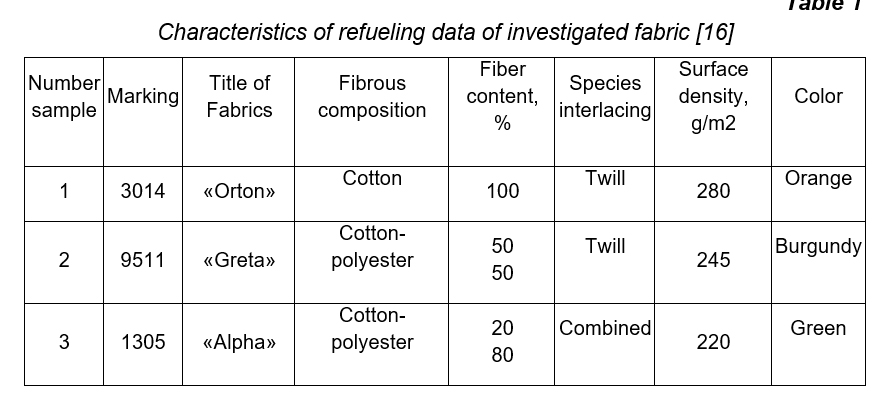NVESTIGATION ON STABILITY OF TEXTILE MATERIALS FOR OVERALLS PROCESSED BY NEW BIOCIDAL PREPARATIONS
Abstract
This article is devoted to the research of new promising biocidal preparations, in particular ethyl, allyl and methyl, which promote the improvement of the consumer properties of textile materials and increase their durability. The problem of protecting textile materials and products from microbiological destruction is complex and multifaceted, and its successful solution requires coordinated and focused efforts of specialists of various profiles. Of particular relevance is the search for effective ways to protect against microbiological destruction of textile materials.
And today one of such methods of protection is to provide textiles with biocidal properties, which not only prevents the growth of bacteria, but can also provide a high level of wear resistance of tissues.
The aim of the work was to study the impact of new low-toxic biocidal drugs on the stability of coloring of textile materials to the effect of various physical and chemical factors.
In the research, the method and technology of providing biocidal properties to textile materials for the production of overalls, in particular, impregnation of textile materials in alcoholic solution of biocidal preparations, was developed. As samples were selected fabrics of different chemical composition, which are intended for the manufacture of overalls.
The best results were obtained with dry friction, and, treatment, does not significantly affect the stability of color, and in the case of cotton-polyester fabric, on the contrary, even increases it. Low indicators of the stability of color to the action of wet friction is due to the low resistance of colors to water.
References
Pakholiuk, E. & Martirosyan, І. (2018). Investigation of the efficiency of biocide substances for the treatment of special textile materials. Tovaroznavchij visnik, Lutsk. Ukraine, Issue 11(2), 100-109.
Halik, I. & Semak B. (2014). Ecological safety of textile: problems and decisions. Herald of Khmelnytskyi national university, Issue 6, 88-90.
Halik, I. & Semak B. (2014). Textile materials protection from pathogenic microorganisms. Visnik KNUTD, vol.6 (80), 143-148.
Faheem, Uddin (2014). Environmental Concerns in Antimicrobial Finishing of Textiles. International Journal of Textile Science., vol.3(1A),15-20.
Zikeli, S. (2006). Production process of a new cellulose fiber with antimicrobial properties. Curr Probl Dermatol, vol. 33, 110-126.
Krichevskiy, G. (2011). Nano-, bio-, chemical technologies in production of new generation of fiber, textiles and clothes. Moscow. "Izvestiya".
Kalontarov, I. & Liverant, V. (1981). Infusion of biocidal qualities and durability to microorganism. Dushanbe.
Windler, L.; Height, M. & Nowack, B. (2013). Comparative evaluation of antimicrobials for textile applications., vol. 4 (53), 62–73.
Collier, B.J. & Tortora, P.G. (2001). Understanding Textiles; Prentice Hall: Englewood Cliffs, NJ, USA.
Pakholiuk, E.V. & Martirosyan, І. A. (2018, March). Modern biocidal substances for the processing of textile materials: their composition and properties. 5th International Scientific and Practical Internet Conference "Urgent issues of theory and practice of commodity expertise". Poltava.
Jean-Yves Maillard, (2005). Antimicrobial biocides in the healthcare environment: efficacy, usage, policies, and perceived problems, Ther Clin Risk Manag, vol. 4, 307–320.
Simoncic, B. & Tomsic, B. (2010). Structures of novel antimicrobial agents for textiles, A Review, Textile Research Journal, vol. 16, 1721-1737.
Uddin, F. & Farooq, M. (2013). Study of fruit waste in antimicrobial finishing of cellulose, BS project, Textile Engineering, BUITEM.
Beyond Pesticides. (2013, December). Report highlights risk from antibacterial chemicals in clothing [Adobe Digital Editions version] Retrieved from http://www.beyondpestic ides.org/dailynewsblog.?p=6534
Product Authorization (2013, Jan). Registration Process under Biocidal Products Regulations (BPR), Retrieved from: http://www.hse.go ve.uk/biocides/bpd/prodauth.htm
LLC "Special Textile". Fabrics for workwear, fabrics wholesale in Ukraine. (2018). Retrieved from: http://spectextile.com.ua/view_main_taximage
National Standards of Ukraine (2008). Cotton and mixed fabrics for garments. General specifications. (21790:2008). Kiev.
National Standards of Ukraine, ISO. (2008). Textiles. Determination of dimensional change in washing and drying. (5077:2008). Kiev.

Copyright (c) 2018 І. Мартиросян, Е. Похолюк, В. Любинець, О. Передрій

This work is licensed under a Creative Commons Attribution-ShareAlike 4.0 International License.



